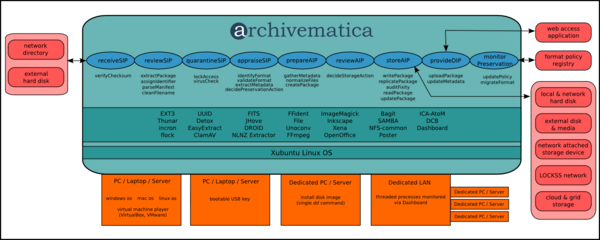Micro-services
Main Page > Overview > Micro-services
The Archivematica micro-services are based on the project's use case and workflow analysis of the ISO-OAIS functional model. Each service is available to a conceptual entity that is equivalent to an OAIS information package:
- Submission Information Package (SIP)
- Archival Information Package (AIP)
- Dissemination Information Package (DIP)
These packages are moved from one service to the next using the Unix pipeline design pattern implemented with a combination of Bash and Python scripts. Each service is provided by one or more of the open-source software utilities and applications bundled in the Archivematica system.
In early iterations of the Archivematica system, some of the workflow controls (e.g. event triggering, error reporting, etc.) are handled via the Thunar file manager (e.g. drag-and-drop, desktop notifications). As the system approaches beta maturity all of the micro-services workflow will be managed via a web-based Dashboard application.
Archivematica Micro-services
| Micro-service | Description |
|---|---|
| Create SIP backup | Archivematica automatically creates a backup of the entire SIP as soon as it is ingested. |
| Verify SIP compliance | This micro-service verifies that the SIP conforms to the folder structure required for processing in Archivematica. |
| Assign file UUID and checksums | Each file in the SIP is assigned a universal unique identifer and an sha-1 checksum. |
| Verify metadata directory checksums | If the SIP contained a checksum.md5 file on ingest, Archivematica will check it to confirm that none of the files were deleted or altered on ingest. |
| Create DC | A Dublin Core xml template is added to the metadata folder in the SIP. The user can fill in fields as desired. The elements map to fields in ICA-AtoM when the DIP is uploaded. |
| Appraise SIP for submission | The archivist reviews the SIP, if desired, to confirm that it complies with any submission agreements. The archivist can delete unwanted files at this point; Archivematica will keep a log of the deleted files. |
| Quarantine | The SIP is placed in quarantine for a pre-set period of time. The archivist can move the SIP out of quarantine before the pre-set time has expired, if desired. |
| Extract packages | |
| Sanitize file and directory names | |
| Scan for viruses | |
| Characterize and extract metadata | |
| Normalize | |
| Compile METS file | |
| Create AIP checksum | |
| Prepare AIP | |
| Store AIP | |
| Generate DIP | |
| Upload DIP |
